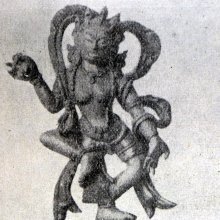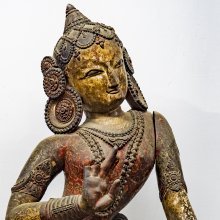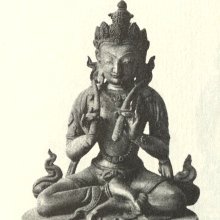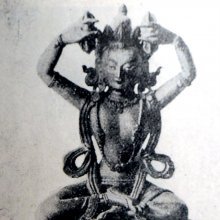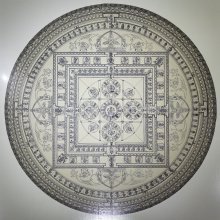Lasya, Lāsya, Lāsyā: 20 definitions
Introduction:
Lasya means something in Buddhism, Pali, Hinduism, Sanskrit, Hindi. If you want to know the exact meaning, history, etymology or English translation of this term then check out the descriptions on this page. Add your comment or reference to a book if you want to contribute to this summary article.
Alternative spellings of this word include Lasy.
Images (photo gallery)
(+2 more images available)
In Hinduism
Natyashastra (theatrics and dramaturgy)
Source: Wisdom Library: Nāṭya-śāstraLāsya (लास्य) refers to a “gentle form of dance”, in the form of a specific type of dramatic play (nāṭya) similar to that of the Bhāṇa type, according to the Nāṭyaśāstra chapter 20.
There are twelve types of the lāsya defined:
- geyapada,
- sthitapāṭhya,
- āsīna (or āsīnapāṭhya),
- puṣpagaṇḍikā,
- pracchedaka,
- trimūḍha,
- saindhava,
- dvimūḍhaka,
- uttamottamaka,
- vicitrapada,
- uktapratyukta,
- bhāvita (or bhāva).
According to the Nāṭyaśāstra chapter 31, “it is said that the lāsya is so called because of its shining (lāsana). It relates to mutual attraction of men and women, and like the bhāṇa it is to be performed by one person, and its subject-matter also should be suitable”.
Source: archive.org: The mirror of gesture (abhinaya-darpana)Lāsya dancing is very sweet.
Source: svAbhinava: Abhinavagupta’s Treatment of the lāsyāṅgasLāsya (लास्य) is a gentle dance. The word lāsya is derived from the root ‘las’ meaning to play, to frolic. It is so called due to the mutual state of attraction between a woman and a man. Abhinava explains ‘lasana’ as ‘krīḍā’—the sportive state. It is the mutual jo ining of one’s mind with that of the other, i.e., the state of attraction of a wo man in regard to a man or of a man in regard to a woman.

Natyashastra (नाट्यशास्त्र, nāṭyaśāstra) refers to both the ancient Indian tradition (shastra) of performing arts, (natya—theatrics, drama, dance, music), as well as the name of a Sanskrit work dealing with these subjects. It also teaches the rules for composing Dramatic plays (nataka), construction and performance of Theater, and Poetic works (kavya).
Sports, Arts and Entertainment (wordly enjoyments)
Source: archive.org: Syainika Sastra of Rudradeva with English Translation (art)Lāsya (लास्य) refers to the “theatrical style of dancing”, according to the Śyainika-śāstra: a Sanskrit treatise dealing with the divisions and benefits of Hunting and Hawking, written by Rājā Rudradeva (or Candradeva) in possibly the 13th century.—Accordingly, “[...] It has been said that there are eighteen addictions. These are the outcome of the desire for earthly enjovments. [...] Dancing is of two kinds—the wild, called tāṇḍava, and the theatrical, called lāsya. It is accompanied with chārī or amorous gait and laya or keeping time. [...]”.

This section covers the skills and profiencies of the Kalas (“performing arts”) and Shastras (“sciences”) involving ancient Indian traditions of sports, games, arts, entertainment, love-making and other means of wordly enjoyments. Traditionally these topics were dealt with in Sanskrit treatises explaing the philosophy and the justification of enjoying the pleasures of the senses.
In Buddhism
Tibetan Buddhism (Vajrayana or tantric Buddhism)
Source: Google Books: An Illustrated History of the MandalaLāsyā (लास्या) is the deity associated with Dṛṣṭi (“looking”): one of the Seventeen Viśuddhipadas (“stations of purity”), according to the Prajñāpāramitānayasūtra: an ancient Buddhist Tantric text recited daily in the Japanese Shingon sect which is closely related to the Sarvatathāgatatattvasaṃgraha.—The seventeen-deity maṇḍala, representing the deification of the seventeen viśuddhipadas, corresponds to the great maṇḍala described in the Mahāsamayatattvavajra, which explains seventeen viśuddhipadas (twenty in the Chinese translation). [...] Iconographically, these Goddesses (e.g., Lāsyā) correspond to the four inner offering goddesses of the Vajradhātu-maṇḍala. [...]
Source: archive.org: The Indian Buddhist IconographyLāsyā (लास्या) refers one of four dance-deities, commonly depicted in Buddhist Iconography, and mentioned in the 11th-century Niṣpannayogāvalī of Mahāpaṇḍita Abhayākara.—Her Colour is red; her Symbol is lāsya dance; she has two arms.—All these four deities (viz., Lāsyā) are popular in the Vajrayāna pantheon and are described times without number both in the Sādhanamālā as well as in the Niṣpannayogāvalī.
Lāsyā is described in the Niṣpannayogāvalī (pañcaḍāka-maṇḍala) as follows:—
Source: academia.edu: The Structure and Meanings of the Heruka Maṇḍala“Lāsyā is of red colour and with pride she arranges her two hands in the lāsya act”
[All these dance-deities are violent in character with garland of severed heads, and dance in pratyālīḍha. They show the tarjanī against the chest as the common gesture.]
Lāsyā (लास्या) is the name of a Ḍākinī who, together with the Vīra (hero) named Lāsya forms one of the 36 pairs situated in the Ākāśacakra, according to the 10th century Ḍākārṇava chapter 15. Accordingly, the ākāśacakra refers to one of the three divisions of the dharma-puṭa (‘dharma layer’), situated in the Herukamaṇḍala. The 36 pairs of Ḍākinīs [viz., Lāsyā] and Vīras are dark blue in color; they each have one face and four arms; they hold a skull bowl, a skull staff, a small drum, and a knife. Alternatively, the Ḍākinīs have their own marks and motions according to the taste instead of a small drum and a skull staff.
Source: OSU Press: Cakrasamvara SamadhiLāśyā (लाश्या) refers to the “(sixteen) dances”, according to Buddhist teachings followed by the Newah in Nepal, Kathmandu Valley (whose roots can be traced to the Licchavi period, 300-879 CE).—[...] Within the gurumaṇḍala the mantra-pātra, from the Cakrasaṃvara-samādhi and Vāruṇī-pūjā is also worshiped, along with caṇḍalī-yoga, “yogic heat”, as amṛta-kuṇḍalī, “the nectar of kuṇḍalinī (yoga)”. The gurumaṇḍala also contains the ṣoḍaśa-lāśyā, “the sixteen dances”, which is actually sixteen dancing Goddesses, which symbolize offerings of the senses, and are usually performed using mudrās, “hand gestures”.

Tibetan Buddhism includes schools such as Nyingma, Kadampa, Kagyu and Gelug. Their primary canon of literature is divided in two broad categories: The Kangyur, which consists of Buddha’s words, and the Tengyur, which includes commentaries from various sources. Esotericism and tantra techniques (vajrayāna) are collected indepently.
Languages of India and abroad
Sanskrit dictionary
Source: DDSA: The practical Sanskrit-English dictionaryLāsya (लास्य).—[las-ṇyat]
1) Dancing; a dance; आस्ये धास्यति कस्य लास्यमधुना (āsye dhāsyati kasya lāsyamadhunā) ... वाचां विपाको मम (vācāṃ vipāko mama) Bv.4.42; R.16.14.
2) A dance accompanied with singing and instrumental music.
3) A dance in which the emotions of love are represented by means of various gesticulations and attitudes; अरुणाधरकिरणबालकिसलयलास्यहेतुभिः (aruṇādharakiraṇabālakisalayalāsyahetubhiḥ) Daśakumāracarita 2.5.
-sya- A dancer, an actor.
-syā A dancing girl.
Derivable forms: lāsyam (लास्यम्).
Source: Cologne Digital Sanskrit Dictionaries: Edgerton Buddhist Hybrid Sanskrit DictionaryLāsyā (लास्या).—name of a goddess or yoginī (Dance personified): Sādhanamālā 157.12 etc.; 324.6.
Source: Cologne Digital Sanskrit Dictionaries: Shabda-Sagara Sanskrit-English DictionaryLāsya (लास्य).—n.
(-syaṃ) 1. Dancing in general. 2. Symphony, or union of song, dance, and instrumental music. 3. A mode of dance in which the emotions of love are represented mimically, the Nautch of India, or dance practised by women chiefly, and confined to attitude and gesticulation, with a shuffling motion of the feet seldom lifted from the ground; this style is said to have been invented by Parvati, and communicated by her to the daughter of Vanasura, by whom her female friends and companions were instructed in it; as a species, it is opposed to the Tandava, the most boisterous dance of Siva, and his followers or men. 4. A part or embellishment of dramatic composition, the occasional introduction of music and singing; also abrupt transition from Prakrita to Sanskrit and from Sanskrit to Prakrita, &c. m.
(-syaḥ) A dancer. f.
(-syā) A female dancer. E. las to be skilled in the art of dancing, ṇyat aff.
Source: Cologne Digital Sanskrit Dictionaries: Benfey Sanskrit-English DictionaryLāsya (लास्य).—i. e. lāsa + ya, I. m. A dancer. Ii. f. yā, A female dancer. Iii. n. 1. Dancing. 2. Union of dance and music, Mārk. P. 68, 26. 3. The dance of the Indian dancing girls.
Source: Cologne Digital Sanskrit Dictionaries: Cappeller Sanskrit-English DictionaryLāsya (लास्य).—[neuter] dance; [masculine] dancer.
Source: Cologne Digital Sanskrit Dictionaries: Monier-Williams Sanskrit-English Dictionary1) Lāsya (लास्य):—[from las] n. dancing, a dance ([especially] accompanied with instrumental music and singing), a dance representing the emotions of love dramatically (this was at one time a principal part of the drama, and as such [according to] to Bharata and the Daśa-rūpa consisted of 10 divisions or Aṅgas, viz. geya-pada, sthita-pāṭhya, āsīna, puṣpa-gaṇḍikā, pracchedaka, tri-gūḍha or tri-mūḍhaka, saindhava, dvigūḍhaka or vimūḍhaka, uttamottamaka, and ukta-pratyukta; including also a style of dramatic composition in which there is abrupt transition from Sanskṛt to Prākṛt and from Prākṛt to Sanskṛt; the term lāsya is also applied to the Nāch [Nautch] dance of the Indian dancing girls, consisting chiefly of gesticulation with a shuffling movement of the feet forwards and backwards, as invented by Pārvati and opposed to the boisterous masculine dance called Tāṇḍava practised by Śiva and his followers; cf. [Indian Wisdom, by Sir M. Monier-Williams 467]), [Mahābhārata; Kāvya literature] etc.
2) [v.s. ...] m. a dancer, [Mārkaṇḍeya-purāṇa]
3) [v.s. ...] Name of a king, [Viṣṇu-purāṇa]
4) Lāsyā (लास्या):—[from lāsya > las] f. a dancing girl, [cf. Lexicographers, esp. such as amarasiṃha, halāyudha, hemacandra, etc.]
Source: Cologne Digital Sanskrit Dictionaries: Yates Sanskrit-English DictionaryLāsya (लास्य):—(syaṃ) 1. n. Dancing; union of song, dance, &c. m. f. A dancer.
Source: DDSA: Paia-sadda-mahannavo; a comprehensive Prakrit Hindi dictionary (S)Lāsya (लास्य) in the Sanskrit language is related to the Prakrit word: Lāsa.
[Sanskrit to German]
Sanskrit, also spelled संस्कृतम् (saṃskṛtam), is an ancient language of India commonly seen as the grandmother of the Indo-European language family (even English!). Closely allied with Prakrit and Pali, Sanskrit is more exhaustive in both grammar and terms and has the most extensive collection of literature in the world, greatly surpassing its sister-languages Greek and Latin.
Hindi dictionary
Source: DDSA: A practical Hindi-English dictionaryLāsya (लास्य) [Also spelled lasy]:—(nm) a kind of graceful female dance.
...
Kannada-English dictionary
Source: Alar: Kannada-English corpusLāsya (ಲಾಸ್ಯ):—
1) [noun] a merry, playful, mirthful movement or series of such movements.
2) [noun] (dance.) a dance accompanied by songs and instrumental music.
3) [noun] a dance in gen.
4) [noun] a style of dance consisting mainly of gesticulation with a shuffling movement of the feet forwards and backwards, as opp. to the boistrous masculine dance.
5) [noun] a female dancer; a dancing girl; ಲಾಸ್ಯವಾಡು [lasyavadu] lāsyavāḍu to dance.
Kannada is a Dravidian language (as opposed to the Indo-European language family) mainly spoken in the southwestern region of India.
See also (Relevant definitions)
Starts with: Lasyaka, Lasyanga.
Ends with (+3): Abhilashya, Alasya, Analasya, Anulasya, Ashtakalasya, Ashtalasya, Bhrulasya, Dehalasya, Halasya, Kalashya, Karkalasya, Lalasya, Mamjulasya, Mohalasya, Nidralasya, Nilasya, Niralasya, Shariralasya, Shodashalashya, Sthulasya.
Full-text (+46): Lasyanga, Lasyaka, Anulasya, Sthitapathya, Uktapratyukta, Pracchedaka, Vicitrapada, Uttamottamaka, Pushpagandika, Dvimudhaka, Lasa, Asinapathya, Trimudhaka, Saindhavaka, Bhavita, Geyapada, Nritya, Pravaga, Asina, Kora.
Relevant text
Search found 28 books and stories containing Lasya, Lāsya, Lāsyā; (plurals include: Lasyas, Lāsyas, Lāsyās). You can also click to the full overview containing English textual excerpts. Below are direct links for the most relevant articles:
The Indian Buddhist Iconography (by Benoytosh Bhattachacharyya)
Figure 206 - Four Dance Deities: Lāsyā
Figure 208 - Four Dance Deities: Nṛtyā
Gati in Theory and Practice (by Dr. Sujatha Mohan)
Analysis of technical terms: Tāṇḍava and Lāsya < [Chapter 1 - Nāṭya]
Gati performed in Lāsyāṅgas < [Chapter 3 - Application of gati in Dṛśya-kāvyas]
Gati in Maṇipurī < [Chapter 4 - Practice of Gati]
Guhyagarbha Tantra (with Commentary) (by Gyurme Dorje)
Text 1.10 (Commentary) < [Chapter 1 (text and commentary)]
Text 4.20 (Commentary) < [Chapter 4 (text and commentary)]
Text 7.4 (Commentary) < [Chapter 7 (text and commentary)]
Bhakti-rasamrta-sindhu (by Śrīla Rūpa Gosvāmī)
Verse 4.8.84 < [Part 8 - Compatible & Incompatible Mellows (maitrī-vaira-sthiti)]
Verse 3.3.88 < [Part 3 - Fraternal Devotion (sakhya-rasa)]
Dasarupaka (critical study) (by Anuru Ranjan Mishra)
Part 3-6 - Bhāṇa rules < [Chapter 2 - Bhāṇa (critical study)]
Part 3-6 - Vīthī rules < [Chapter 7 - Vīthī (critical study)]
Part 16 - Conclusion < [Chapter 1 - Nāṭaka (critical study)]
